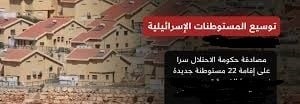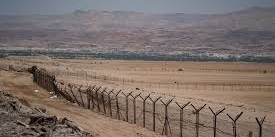By: Madeeha Araj,
The Israeli government does not spare any opportunity to develop settlement in the West Bank, including occupied East Jerusalem, and all C areas classified in the agreements signed between the Palestinian and Israeli sides, benefiting from the American administration’s positions. In the Salfit governorate, the occupation authorities began implementing the railway project, which in the first stage connects “Ariel” settlement with the Green Line. It consists of 3 stages, the first phase will end in 2025 at a cost of NIS illion 3,000,000 on a 2,000 dunums of the lands of the Al-Zawia, Masha, Badia, Saratah, Kafr-Deek and Bruqin villages, which means destruction of agricultural lands, uprooting trees and water sources. The Israeli occupation authorities plan to build 11 West Bank railways with a length of 475 km, 30 rail-station at Rosh Pinam and Btah-Taqfa in the Ras-Ein area in 1948, and Ariel and Barkan, “Arail” and “Tufuh” settlement.
In fact, Israel launches a comprehensive war on the Palestinian presence in C areas, in order to grant them to settlers, despite the UN Human Rights Council’s adoption of 4 resolutions condemning Israel’s policies in the 1967 war. They confirmed the inalienable right of the Palestinian people to self-determination, the establishment of an independent and sovereign State and the end of Israel’s occupation of the Palestinian territories, including East Jerusalem, and the right of the Palestinian people to permanent sovereignty over its natural resources on the 1967 borders, and to prevent Israel from building of settlement units and roads in the “Nejehot” settlement in Hebron in order to link it with other settlements, so confiscating an area of 291 donums.
According to the plan, it occupied basin no 21 in Qfafis village and basin 4 in the Um-Hadora village, thus the Israeli occupation intends to build 102 new settlement units. The Israeli authorities reduces the construction along the road no. 345 from the distance of 30 – 100m, worth mentioning that the road links the Dura city and its western villages. In Jerusalem, settlement activity continues, as the “Euro Israel co.” announced the sale of 22 housing units of the “Euro Pisgat” project in the “Pisgat Ze’ev” settlement in occupied Jerusalem, which includes 122 housing units in 11 buildings, each consists of 11 housing units, a park, an artificial waterfall and a theater, swimming pool and sports rooms. It also prepares to build 4 projects in Jerusalem, 2 projects in Pisgat Ze’ev, the first, 24 housing units and the second 122 units, and a project in the Har Homa settlement in Jabel Abu-Ghneim in Jerusalem, where it is constructing 122 housing units and another in the “Nabi Ya’akov” settlement consisting of 78 units.
On the other hand, Tsarfti Shamoon co. laid last week the foundation stone for a new settlement project called “Tsarfati in Pisgat Zeev”, which includes the construction of 92 residential units. Avi Tsarfati, General Manager of the company, said at a ceremony held on this occasion, this is the first stage of a project that includes the construction of 300 units Housing units. “The Israeli occupation authorities began housing 450 settler families in a new neighborhood of the Giv’at Ze’ev settlement, and more than 30 settler families that arrived from the USA, which is being built on the lands of Jalud village, southeast of Nablus, to accommodate the settlers of “Amona” On the other hand, Tsarfti Shamoon co. laid last week the foundation stone for a new settlement project called “Tsarfati in Pisgat Zeev”, which includes the construction of 92 residential units. Avi Tsarfati, General Manager of the company, said at a ceremony held on this occasion, this is the first stage of a project that includes the construction of 300 units Housing units. “The Israeli occupation authorities began housing 450 settler families in a new neighborhood of the Giv’at Ze’ev settlement, and more than 30 settler families that arrived from the USA, which is being built on the lands of Jalud village, southeast of Nablus, to accommodate the settlers of “Amona”. In a serious development, the Israeli Occupation Prosecution acquitted settlers from the settlement of Yitzhar, located on the ‘Asira al-Qibliya land to the south of Nablus City from his crime of assassinating Mah’d Odeh, 48 in the village of Qusra near the city of Nablus, at the end of November.
During his tour in Etsion settlement south of Bethlehem, Avigdor Lieberman said, I reviewed the situation of 2000, I can say, there was no such momentum, and it must continue at a high pace in the West Bank, adding when we look back at the figures of 2017, we approved the building of some 11,500 settlement units. In 2018, we agreed to build 2,700 settlement units, and I hope this momentum will continue. “
Within this context, the Israeli Peace Now Movement said in its annual report about building settlements in 2017 in the West Bank, excluding Jerusalem, that construction increased by 17% more than the annual rate during most of the last decade at “Ameihai settlement”, south of Nablus, and 3 new outposts north of Ramallah, and one south of Jericho. 977 donums were declared state land, south of Nablus as part of an attempt to legitimize the illegal settlement outposts in Givat Haroobalji Mayim. The movement has approved the construction of 31 housing units in the heart of Hebron to be a new settlement complex on a land includes the old central bus station.
A list of Israeli Occupation and Settlers’ Assaults Over The Last Week, Documented by the National Bureau:
Jerusalem: Talmudic prayers and offering s near the Al-Aqsa Mosque, along with a judicial decision that allows settlers to perform their prayers before the Mosque, besides military training to break into the Al-Aqsa Mosque and close the Old City. The Israeli police allowed the activists of the “temple” to perform the rituals of the “Easter” sacrificial ceremonies near the Umayyad Palaces adjacent to the Al-Aqsa Mosque.
- Demolishing notices for 9 houses in the Silwan town in the Abbasiya neighborhood, south of Al-Aqsa Mosque, under the pretext of building without a permit.
- Breaking into the house of the Jerusalemite activist, Amal Qasim in the Sheikh Jarrah neighborhood in the center of occupied Jerusalem. Qasim said her daughters were terrified by the occupation soldiers.
Hebron:
. Breaking into Palestinian buildings in the Old City of Hebron, attacking citizens and their property.
- Seizing two Palestinian buildings in the city of Hebron near the Al-Ibrahimi Mosque, belonging to the Za’tara family, claiming the ownership of the 2 houses and registering them in the Land Registration Department, one of which was called “Beit Rachel” and the other “Beit Lea“.
- Attacking child, Nader Ziad Abu Eisha, 8 years in the TeliRumeida area in Hebron.
- Demolishing a residential tent in the area of Raghm al-Hamra, east of Yatta, south of Hebron, east of Yatta, belonging to Khader al-Nawaj’a, under the pretext of building in a military area.
- Preventing farmers and supporters from planting trees in Al-Tuwani village south of Hebron, assaulting journalists and arresting a girl.
- 35-Attacking shepherded, Jom’a Mosa Rabi’, 45, severely beaten, causing him fractures and bruises.
Bethlehem:
- Demolishing a 180-square-meter house, belonging to Nader Mah’d Abu-Khayara, in the Walaja village and the area of ‘Ain al-Juweiza, northwest of Bethlehem..
- The Al-Khader Municipality, south of Bethlehem, was prevented from opening agricultural road in Um Rakaba, which the municipality is working to use it as an alternative to the main entrance of the town.
- Confiscating 5 tents for farmers in the Nahalin town, “Ein Fares” area west of the town, closing the agricultural road connecting the land in the area of “Ein Kassis” with rocks and solid wastes.
Ramallah:
- Attacking activity for planting trees near the “Shilo” settlement, attacking the participants, and uprooting trees. Israeli soldiers and settlers fired live ammunition to against the activists.
Nablus:
- Preventing farmers from Tal village west of Nablus from working in their land near the “Gilad” outpost in the southern area of Til village even though they had a permit to work for 3 days in their land.
- Wounding, Taysir Hasan Suleiman, from Hawara village, south of Nablus, as he was attacked by the settlers in his land in the Al-Lahaf area, causing fractures of his jaw and head wounds. He was transferred to Rafidya Hospital.
- Storming the Qaryut village, southeast of Nablus, under the protection of the Israeli occupation forces. They carried out barbaric acts and sang anti-Arab songs.
- Removing guide plates at the archaeological site in Sebastia which are used as guidance to visitors and tourists to move around the archaeological sites in the town, demanding these signs shall include Hebrew language in addition to the Arabic and English.
Qalqilia:
- Attacking, Yosef Joma’ from Amatin village, east of Qalqiliya. Wounding him in the head and was taken to Rafidia Hospital.
 المكتب الوطني للدفاع عن الارض ومقاومة الاستيطان منظمة التحرير الفلسطينية
المكتب الوطني للدفاع عن الارض ومقاومة الاستيطان منظمة التحرير الفلسطينية




